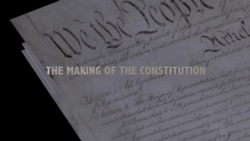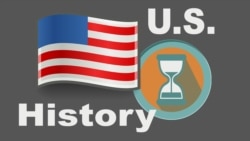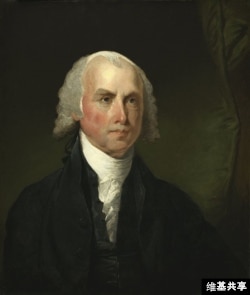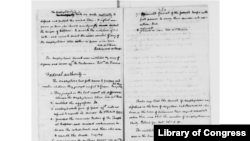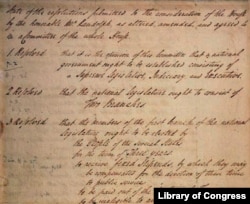The men who created the U.S. Constitution are often called the country’s “founders” or “framers.” But only one framer is known as "the father of the Constitution." He is James Madison.
Madison did not have the physical appearance of many politicians. He was a short man with a soft voice who had often been sick as a child and young adult.
He grew up in a wealthy family in Virginia and enjoyed reading and studying. He went to college at the school that later became Princeton. For a while, he did not know what kind of career he wanted.
When the Revolutionary War started between the colonists and the British, Madison’s intelligence and knowledge helped him participate in debates about independence and a new American government. He eventually became a member of the Continental Congress.
After the Revolutionary War, he urged the Confederation Congress to call for a convention to strengthen the national government.
Tom Howard is an educator at Madison’s house in southern Virginia.
“James Madison doesn’t enjoy a lot of press, he’s not somehow historically as well-known as other of our founding statesmen, but he’s certainly every bit as important … We are not even sure there would be a Constitution had it not been for James Madison.”
Mr. Howard tells how James Madison used his library to prepare for the Constitutional Convention.
“He went up there and studied for months, and that’s having just a light breakfast and then studying throughout the entire day before he finally took a break to rest up, to go back at it the next day.”
Madison studied other governments in history and governments operating in the world at the time. He studied the confederacies of Ancient Greece and the Holy Roman Empire, as well as the Swiss Confederacy. Mr. Howard points out that Madison could read in seven different languages – a helpful skill for his work.
Madison used what he learned to write a paper called “Ancient and Modern Confederacies.” One of the most important ideas he found was that a weak government could invite problems.
Mr. Howard says Madison’s reading informed his thinking about the U.S. Constitution. And, in turn, Madison’s thinking informed the discussion at the Constitutional Convention. His recommendations for a strong central government became the basis for the delegates’ conversation.
“We consider the old library in the Madison house pretty much of a little cradle of our constitutional form of government, because of all of the time he spent.”
Only 37 years old, Madison did not have the authority of many of the other delegates. But he was the most prepared.
How do we know what happened at the convention?
James Madison influenced the Constitutional Convention in another way, too. He took detailed notes about the meeting.
“He sat behind George Washington taking notes, and trying to determine how the debates were going in discussions that he could prepare for the next day, and how he would influence that.”
Madison understood his notes were important not only for him. He knew they would be important for historians and other people who would want to know what happened in Philadelphia. He included the speeches other delegates made and their exchanges of ideas.
But, because the delegates to the convention agreed to keep their discussion secret, Madison waited until all the delegates had died – including himself – to allow his notes to be made public.
They were published in 1840, more than 50 years after the delegates met in Philadelphia. Much of what we know today about the Constitutional Convention is because of Madison’s notes.
Ratification and the Federalist Papers
After the Constitutional Convention, the states had to take another step. The legislatures of each state had to ratify, or vote to approve, the new constitution.
Again, James Madison worked with other state leaders. Along with Alexander Hamilton and John Jay, Madison wrote a series of papers to persuade state legislators to adopt the Constitution.
In “The Federalist Papers,” Madison and his fellow writers explained why the government described in the Constitution would be the best government for the United States. None of the writers signed his own name. They all used the name “Publius,” which means “people” or “of the people” in Latin.
In one of the papers, Madison discussed one of the public’s fears about a national government. Many worried about a “tyranny of the majority.” In other words, they were afraid that 51% of the population could dominate the other 49%.
Educator Tom Howard explains that Madison argued that a national population would have a greater number of groups, or factions, with different interests.
“And he felt that if a larger number of factions, a larger number of interests, would result in more of a consensus, certainly, than having one dominate over the other.”
Madison also wrote in “The Federalist Papers” about checks and balances – in other words, how the Constitution separated power among three parts of government.
“He said that if men were angels there wouldn’t be any necessity for government whatsoever, and clearly they are not. So basically you need some kind of controls.”
Madison and other supporters of the proposed government eventually succeeded in persuading the states to ratify the Constitution. He was elected to the House of Representatives in the first Congress under the new government.
A hard worker and good collaborator
Georgetown University School of Policy Studies professor Lynn Ross thinks Madison might not have been as successful in our modern political world.
"James Madison, who we consider the father of our Constitution, he was actually quite an amazing man. Sort of behind the scenes, interestingly, I mean. I think today he wouldn’t have been as successful because he wasn’t a great charismatic kind of leader, but he was a real compromiser, and he was very diligent, and kind of a behind the scenes operator, but - the father of our Constitution."
Linda Monk is a Constitutional historian.
“The two things I think you can be most proud of about Madison is he’s a practical politician. He can see the big vision, but he’s also a workhorse to get it done.”
The Constitution that James Madison worked hard to "get done" has served the United States for over 200 years. And, it has inspired other constitutions around the world.
I'm Jonathan Evans.
And I’m Jill Robbins.
Dr. Jill Robbins wrote this story for Learning English. Kelly Jean Kelly was the editor.
______________________________________________________________
Words in This Story
confederacy – n. a group of people, countries, organizations, etc., that are joined together in some activity or effort
cradle – n. the place where something begins — usually singular — usually + of
ratify – v. to approve a document officially by voting
consensus n. a general agreement about something; an idea or opinion that is shared by all the people in a group
checks and balances - n. a fundamental principle of American government, guaranteed by the Constitution, whereby each branch of the government (executive, judicial, and legislative) has some measure of influence over the other branches and may choose to block procedures of the other branches
charismatic - adj. having great charm or appeal
Now it's your turn. Do you know who is responsible for your country's constitution? Who helped to found your country? Write to us in the comments section.



